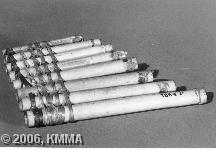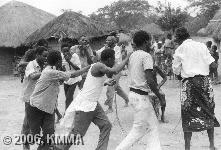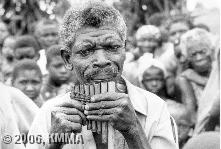


It may seem slightly astonishing but a version of the panpipes can also be found in Bantu Africa, while from the point of view of our European culture we would associate it more with the folk music of Latin America, Oceania and Central Europe. We can assume that the presence of the panpipes in Central and Southern Africa can be regarded as original and not as an introduction from outside. It is striking, however, that the renowned encyclopaedia (New Grove Dictionary of Musical Instruments – subject “panpipes”) makes no mention of their existence in this region of the world.
When it comes to shape and structure, the African panpipes can be compared with other panpipes elsewhere in the world. They are played in the same manner and mostly in ensembles with several other panpipes. Among the Salampasu (Congo-Kasai) we made a recording of several examples of panpipes in the Misengu dance, where they were played by the dancers and accompanied by drums and xylophones. Thirty years ago we were also able to make recordings of panpipes among the Luba (Congo-Katanga). Typically, different pipes were here too played together and we can infer from old photographs that each panpipes comprised 7 to 8 small bamboo pipes. In the examples in the KMMA organological collection, the number of bamboo pipes vary from 4 to 10.
This type of instrument is used in recordings of our sound archives made with the Congolese peoples mentioned hereafter where it appears with the following vernacular names:
Bitanda (Yaka), Kishiba (Mishiba) (Luba-Kasai), Misengu (Sala Mpasu), Mishiba (Luba, Songye), Mishiy (Lunda), Mushiy (Lunda), Tshitebwa (Luba)
Bibliography:
Discography:
© KMMA